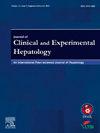"Parvovirus B19 相关急性肝炎:儿童的临床表现和预后"
IF 3.3
Q2 GASTROENTEROLOGY & HEPATOLOGY
Journal of Clinical and Experimental Hepatology
Pub Date : 2024-09-24
DOI:10.1016/j.jceh.2024.102416
引用次数: 0
摘要
背景/目的急性肝损伤是免疫功能低下患者感染 parvovirus B19 (PVB19) 后的常见表现。然而,有关免疫功能正常儿童的文献却很少。我们对 2010 年 1 月至 2023 年 12 月期间因急性病毒性肝炎(AVH)、急性肝功能衰竭(ALF)或急性慢性肝功能衰竭(ACLF)和 PVB19 感染入院的所有儿童(18 岁)的前瞻性数据库进行了回顾性分析。对临床特征、实验室参数和并发症进行了评估。结果 共研究了 35 名患有 PVB19 相关肝炎的儿童(19 名男孩 [54%],中位年龄:7.25 [四分位距:4-10.8] 岁)(28 名 [80%] 单独感染 PVB19,7 名 [20%] 合并感染 [3 名感染 Epstein-Barr 病毒,2 名感染甲型肝炎,1 名感染戊型肝炎和巨细胞病毒])。最常见的表现是 AVH(17 例,占 49%),其次是 ALF(13 例,占 37%)和 ACLF 中的急性损伤(5 例,占 14%)。合并感染的患者胆红素(14.6 [9.4-21.5] vs 6.8 [4.3-10.9] mg/dl;P=0.004)和转氨酶(ALT:697 [428-1296] vs 277 [157-478] U/L;P=0.02)明显高于单独感染 PVB19 的患者,但死亡率相似(1/7 vs 6/23;P=1.0)。九例患者(25.7%)出现肝外并发症(嗜血细胞性淋巴组织细胞增多症[HLH]:3例,急性肾损伤3例,再生障碍性贫血:2例,心肌炎:1例)。38%的ALF病例(5/13)、11.7%的AVH病例(2/17)(HLH:1例,心肌炎:1例)以及无ACLF病例(0/5)出现不良预后。本文章由计算机程序翻译,如有差异,请以英文原文为准。
“Parvovirus B19–related Acute Hepatitis: Clinical Spectrum and Outcome in Children”
Background/Aims
Acute liver injury is a common manifestation of parvovirus B19 (PVB19) infection in immunocompromised patients. However, literature in immunocompetent children is scarce. We aimed to study the clinicolaboratory features and outcome of hepatic involvement by PVB19 infection in hospitalized children.
Methods
We retrospectively analyzed our prospectively kept database of all children (<18 years old) admitted with acute viral hepatitis (AVH), acute liver failure (ALF) or acute-on-chronic liver failure (ACLF), and PVB19 infection between January 2010 and December 2023. Clinical features, laboratory parameters, and complications were evaluated. Poor outcome was defined as death or liver transplantation.
Results
A total of 35 children (19 boys [54%], median age: 7.25 [interquartile range: 4–10.8] years) with PVB19-related hepatitis were studied (28 [80%] isolated PVB19 infection and 7 [20%] coinfections [3 with Epstein–Barr virus, 2 with hepatitis A, and 1 each with hepatitis-E and cytomegalovirus]). AVH (17, 49%) was the most common presentation, followed by ALF (13, 37%) and acute insult in ACLF (5, 14%). Patients with coinfection had significantly higher bilirubin (14.6 [9.4–21.5] vs 6.8 [4.3–10.9] mg/dl; P=0.004) and transaminases (ALT: 697 [428–1296] vs. 277 [157–478] U/L; P=0.02) but similar mortality (1/7 vs 6/23; P=1.0) than PVB19 alone. Nine cases (25.7%) had extrahepatic complications (hemophagocytic lymphohistiocytosis [HLH]: 3, acute kidney injury: 3, aplastic anemia: 2, and myocarditis: 1). Poor outcome occurred in 38% (5/13) ALF, 11.7% (2/17) AVH (HLH: 1, myocarditis: 1), and none (0/5) of the ACLF cases.
Conclusion
PVB19 should be considered in children presenting with indeterminate acute liver injury, especially in younger children or those with complications such as aplastic anemia, HLH, or myocarditis.
求助全文
通过发布文献求助,成功后即可免费获取论文全文。
去求助
来源期刊

Journal of Clinical and Experimental Hepatology
GASTROENTEROLOGY & HEPATOLOGY-
CiteScore
4.90
自引率
16.70%
发文量
537
审稿时长
64 days
 求助内容:
求助内容: 应助结果提醒方式:
应助结果提醒方式:


